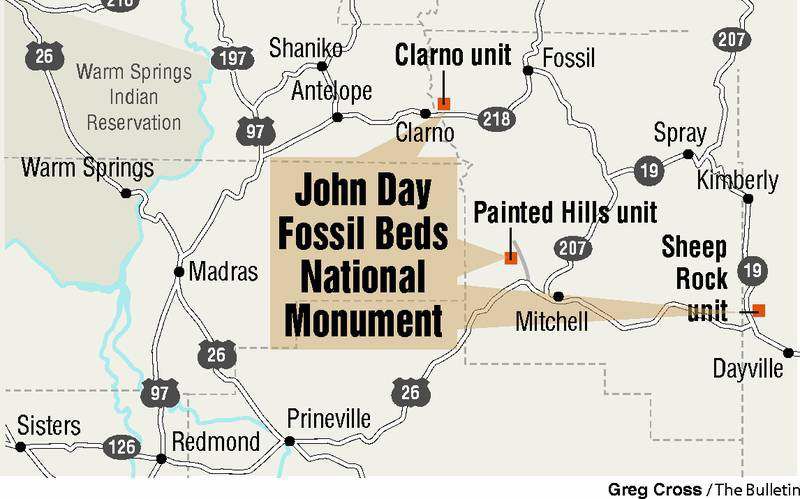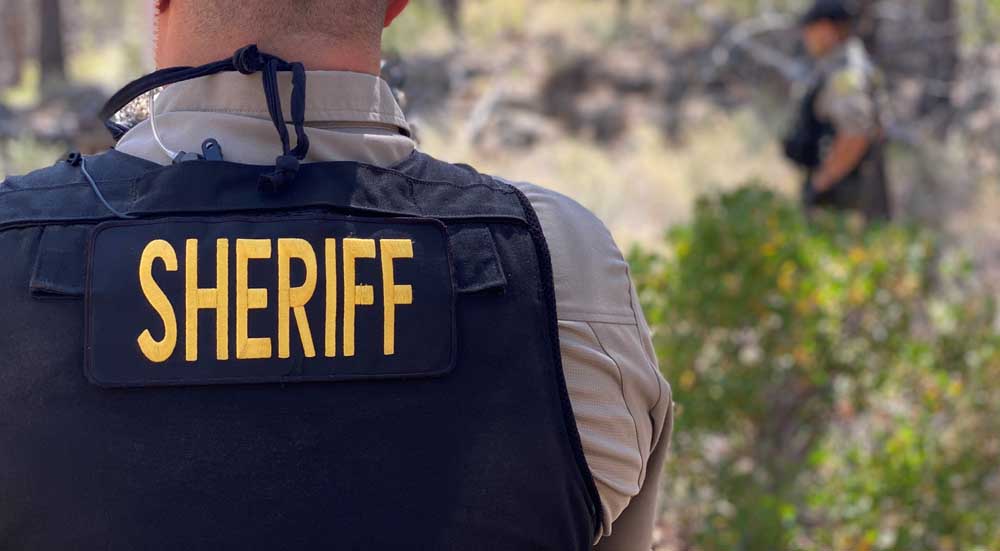Stealing prehistory
Published 4:00 am Sunday, December 9, 2007

- Stealing prehistory
JOHN DAY FOSSIL BEDS — Some summer days, National Park Service Ranger Scott Ritner can simply sit on a bench underneath a gnarly juniper tree and watch people commit a federal offense.
They’ll hop a low wooden fence at the base of Leaf Hill, pick up the bleached rocks that litter the ground and pocket the fossils the John Day Fossil Beds National Monument was named for.
“That’s kind of our problem child,” said Ritner, the ranger for the Painted Hills unit of the monument.
There’s a trail around Leaf Hill, and informational signs with examples of some of the different fossil types found there — ancient sequoias, alders, pines, oaks, even magnolias. The signs tell people what’s there, he said, and it’s human nature to search among the flat white rocks for them, pick them up and keep them as a souvenir.
While the rules about what people can collect vary depending on who manages the land, the illegal removal of fossils from public lands in the John Day Basin is a continuing problem, said staff with both the park service and the Bureau of Land Management. While people pocketing imprints of leaves are a concern in the monument, the theft of fossilized bones from mammals, including creatures distantly related to pigs, happens as well. In one case this year, a search warrant was issued for people who were spotted digging in the monument; the search turned up multiple fossils, including bones from a rhinoceros.
And when people remove fossils illegally, they take away part of the prehistoric story of Eastern Oregon that scientists are trying to piece together.
“It’s not the thing, it’s the story,” said John Zancanella, a Prineville-based paleontologist for the BLM in Oregon and Washington. “When an illegal collector collects, and it goes into a shoebox or a closet, the benefit is for no one.”
It’s difficult to quantify how often fossil theft happens, he said. But the evidence of it can be easy to see, he said.
There are fossil sites that he checks in on to find holes — some small, some 3 feet across — that weren’t there before and weren’t done by a permit-carrying researcher.
In the fossil beds, there are places where scientists have taken pictures of fossils on the ground and come back later to find them gone, said Ted Fremd, chief paleontologist at the monument. And there are other places where people have dug pits or tried to remove bones but did a messy job of it, he said.
“We have a large amount of land, and we have a lot of fossils on it,” said Jim Hammett, superintendent for the 14,000-acre fossil bed monument. “In general, we depend on the public to help us out.”
Illegal digging
That’s what happened earlier this year, when Michelle Ordway, a temporary employee with the park service, was walking near a picnic area of the Sheep Rock unit of the fossil beds with her son. They heard a sound she thought was a hammer on rocks, according to federal court records.
The two kept walking and saw a man and a woman digging a hole about 50 feet from the “Story in Stone” Trail.
When she asked the two what they were doing, the man showed her a 3-inch-long jaw- bone fossil and other fragments they had been digging up, the records state. When she asked if they had permission, the man said yes, and said he was collecting fossils for a talk he was going to give in Burns.
The son then told the man that collecting fossils in the monument was illegal, according to the records, but the man said he didn’t think he was within the monument. He said he would stop collecting and leave, and walked away to take some pictures. Ordway and her son went back to their vehicle and wrote down the license plate number of the only other car in the parking lot — parked illegally in a handicapped spot.
Ordway reported the incident to others at the monument. She later returned to the site with law enforcement officers and paleontologists, who took stock of the damage.
They found a hole that indicated a skull of an oreodont — a sheep-sized animal distantly related to pigs, camels and hippos that lived from 48 million to 4 million years ago — had been removed, according to the records. They also found evidence that people might have dug up and taken other fossils.
The park’s law enforcement agent checked the car’s registration, which led officials to a home in Kelso, Wash.
When a search warrant was served in late October, officials found rhinoceros bones as well as other mammal bones, a rock hammer, petrified wood and commercial fossil specimens, among other things, in the house.
Leaf sneakers
A lot of the rangers’ efforts are aimed at education, Ritner said. He’ll go up to people and talk with them about the park and answer any questions they have — “Where are the dinosaurs?” is a common one, he said, but all these fossils are from the post-dino ages.
But he’ll show them the ones that are common on the Painted Hills unit. On sedimentary rocks bleached from the sun, the outlines of the short needles of the ancient metasequoia or veins of old alder leaves stand out in different shades of brown.
And he’ll explain the monument’s rules, such as not taking fossils or not walking on the fragile surfaces of the painted hills.
For the most part, people behave, he said. Still, he patrols the Painted Hills area regularly, covering the different trails about five times a day.
“I get to see this every day of the year,” he said, overlooking hills banded with colorful layers of bentonite ash.
The reds, oranges, blacks and other colors of the stripes are the result of different trace concentrations of minerals like iron, manganese oxide, zinc and copper. Many of the hills in the area look like this under the surface, but people can only see these colors if there is no vegetation. In the Painted Hills unit, which millions of years ago was covered with lakes and subtropical hardwood forests, there are now mostly scraggly juniper and grasses.
In his patrols of the trails and other areas of the unit, he’ll see people taking chunks of rocks, he said.
In one mound near Leaf Hill, paleobotanists — people who study plant fossils — had excavated a few layers, with permission, to see if they could find any new plant species, Ritner said. They left most of the fossils they dug up on the ground, but later Ritner found people, without permission, coming to the excavated spot to take the fossils.
Taking fossils can result in a fine of $200, he said, and when a teacher brought his class to the area on a field trip to collect fossils, the case went to federal court.
Problem areas
Zancanella, with the BLM, said there are more than 200 spots in the agency’s 1.5 million acres where fossils are common, called localities, and he makes visits to check on them as often as possible.
One area is the rare site of a foothill ecosystem that left fossilized remains. There, people have found all kinds of mammals, from small mouse deer to large birds to primitive marsupials to entelodonts, 6-foot-tall animals with 8-to-10-inch tusks that are dubbed “terminator pigs.” They have even found something that could have been an ancient relation to sea lions, but the bones were what would have been 100 miles from the ocean.
“There’s a very wide variety of specimens that have come from this particular place, and each time we go out, there’s a chance of finding something new,” he said.
But the area had problems with people coming in and digging pits, damaging and removing potentially informative fossils, he said. So the agency worked with nearby landowners to get information on who was coming into the site, made visits and pretty much halted the problem there, Zancanella said.
It’s not easy to focus that much attention on most of the other sites, though.
“We’ve got three people for a million and a half acres, so it’s a daunting task, and it’s one reason why we don’t totally rely on law enforcement,” he said. Other BLM or land management agency employees also keep an eye out for illegal activities, as do visitors familiar with the rules, he said.
Parts of history are being lost
Zancanella and others said that when people remove these fossils, though, they are taking away potentially valuable information.
The fossil beds are unique because they present an incredibly long record of what lived in the area, from about 50 million years ago to about 3 million years ago, Hammett said. While other fossil deposits might be more details about a particular time, the national monument contains fossil records that can give scientists glimpses into the evolution of different animals or of entire ecosystems. In that way, the John Day Fossil Beds are kind of like a book, he said.
“There’s a lot of fossil deposits that are like a single page of a book, and we have the whole book.”
The fossil beds are a complex place with a huge variety of plant and animal species, Fremd said, and that’s what makes them special. Scientists can not only look at what lived there but can use fossils to study changes in ancient climates by looking at things like different forms of oxygen in tooth enamel or the fossilized soils.
“This is the place where you go to find that continuous record,” said Ellen Morris Bishop of the Oregon Paleo Lands Institute. “How did horses change for the last 50 million years? This is where you go to figure that out. How did the climate change? This is where you go to figure that out.”
But if fossils are removed from their context without people carefully noting where they were found and what they were found with, a lot of the information about the animal and its relationship to its environment is lost, she said.
“The greatest loss in someone taking fossils from public lands, or anywhere else, is this loss of information,” she said.
Rules for collecting fossils on public lands
On National Park Service lands: Collecting fossils of vertebrates (animals with a backbone), invertebrates (animals without a backbone, like mollusks), petrified wood and plant fossils is prohibited unless the person has a research permit issued by the National Park Service.
On Bureau of Land Management lands: Collecting fossils of vertebrates is prohibited without a permit. Collecting “a reasonable amount, generally what you can carry” of invertebrate and plant fossils is allowed, but only for personal use — they can’t be sold. Collecting petrified wood for personal use only is allowed, with a maximum of 25 pounds a day and 250 pounds per year.
On U.S. Forest Service lands: Collecting fossils of vertebrates is prohibited without a permit. Collecting petrified wood, invertebrate and plant fossils is allowed for personal use only, but check with local offices for the maximum amounts.
On Oregon state lands: Collecting vertebrate fossils is prohibited without a permit. Check with local offices before collecting petrified wood or invertebrate and plant fossils.
Source: National Park Service, www.nps.gov/joda/planyourvisit/ fossil-collecting-regulations.htm








